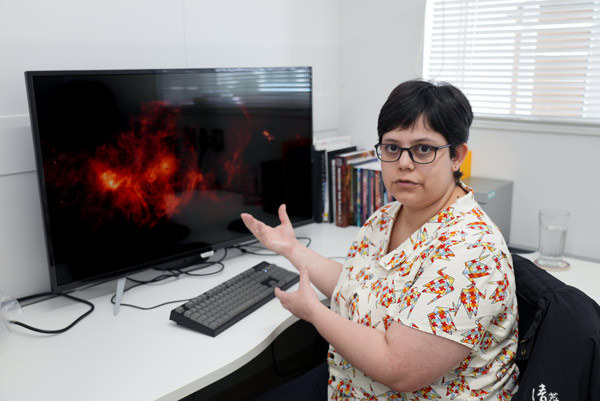Dec. 16, 2022
How do young star clusters form?
Nadia M. Murillo Mejias, Special Postdoctoral Researcher
Describe your role at RIKEN.
I’m currently a special postdoctoral researcher (SPDR) focused on studying the formation and evolution of low-mass multiple protostellar systems. Protostars are the objects from which stars, like our Sun, form. When two or more protostars are in a system, these are called multiple protostellar systems. I apply observational, numerical and experimental techniques to study the physical and chemical structure of these systems.
Briefly describe your current research.
I’m currently leading a project to study the relationships between parameters—such as gas temperature, mass, density and kinematics—in multiple protostellar systems by observing a range of molecular species. Multiple stars are key to many phenomena, from gravitational waves to stellar physics. Observations of star-forming regions have shown that multiple protostellar systems are common, indicating that multiple stars are born as a system rather than created during stellar evolution. Hence, discovering how these systems form and evolve is relevant to understanding a key aspect of stellar physics and evolution.
How did you become interested in your current field of research?
My interest in star formation arose during a winter school on star formation in my sophomore year of university, while I was watching how multi-epoch observations of a molecular outflow could show the motion of these objects. I quickly became interested in multiple protostars, how they were a crucial, but often ignored part of star formation, and the physico-chemical structure of protostars in general.

What do you think has been the most interesting discovery in your field in the last few years?
The last two decades have seen a vast and wonderful increase in our knowledge of star formation at all scales thanks to developments in telescopes, numerical techniques and experiments. Surveys of large regions have shown the physical and chemical properties of star-forming regions. Detailed high-resolution observations have revealed gaps and rings in disks, mass needed for planet formation, inflowing material from cloud to disk scales, amazing outflows and complex chemical structures. All this new knowledge provides context within which I try to make sense of the star-formation process.
What has been your most memorable experience at RIKEN?
I’ve enjoyed the chance to learn how to use different facilities, such as the scanning electron microscope and the infrared instruments at SPring-8.
Tell us about your goals.
I aim to keep doing research on the formation and evolution of multiple protostellar systems. One of my long-term goals is to find a way to connect these systems from the stages of formation through to the end of stellar life-cycle. It would be interesting to explore how the characteristics set during the early stages of star formation transfer (or not) to the other parts of the stellar life-cycle.
Rate this article

